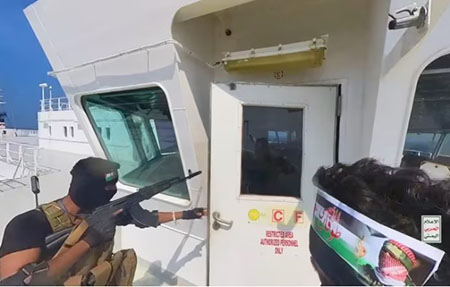Special to WorldTribune.com
 By John J. Metzler, January 12, 2024
By John J. Metzler, January 12, 2024
Islamic Iran is pulling the puppet strings, and its local stooges are jumping to them threatening global commerce. But beyond Hamas terrorists in Gaza, or the Hizbullah in southern Lebanon, this new seaborne threat has emerged in the oft overlooked Red Sea, a vital waterway connecting the Mediterranean with the Arabian Sea.
The Houthi militants, a Yemeni based Islamic militia have taken their fight from the mountainous lands of the Arabian peninsula to the Red Sea waters which serves as a key commercial conduit for merchant ships sailing between Europe and East Asia. Officially the Houthis are involved in a decade-long civil war with Yemen’s central government, and among other things have caused wider poverty and population dislocation in their already poor country.
The current attacks on and seizing of ships recall the Somali pirate threat of a decade ago.
But the Houthis have upped the ante with drones and long-range missile attacks, supplied from Iran, to harass both merchant vessels and U.S. Navy and allied ships escorting them. The armed militants seized the Japanese operated cargo vessel Galaxy Leader in November and still hold the ship and its crew.

The Houthis, officially known as Ansar Allah, were declared a terror organization by the U.S. State Department until President Biden removed them from the nefarious status during the first weeks of his administration.
The Red Sea resembles a giant bottle with two necks; an entrance on the northern top at the Suez Canal controlled by Egypt and the exit in the southern Bab El-Mandeb Straits bordering lawless Yemen. In fact six different countries surround the Red Sea: Saudi Arabia, Sudan, Eritrea, Djibouti and both Egypt and Yemen.
Approximately 15 percent of international trade transits the Red Sea; Rerouting vessels around South Africa’s Cape of Good Hope adds at least an additional ten day ship journey, thus increasing shipping costs and straining supply chains.
Top merchant shipping companies such as Maersk and Hapag-Lloyd have halted Red Sea transits.
Significantly the U.S. Navy as well as France maintain a base in nearby Djibouti so Navy resources while stretched are not remote to the strategic region. More ominously China also has a military base in Djibouti not far from the Western installations.
Currently the Dwight D. Eisenhower Carrier Strike Group is on station off the coast of Yemen, supported by other ships such as guided-missile cruiser USS Philippine Sea and guided-missile destroyer USS Gravely. The Aircraft Carrier Strike Group packs a powerful punch with its Naval Air Squadrons.
Recently when the American ships have come under attack from the land-based Houthis, they have responded in self-defense; A U.S. ship sank three Houthi craft killing ten militants. In mid-December the destroyer USS Carney shot down 14 Houthi-launched unmanned aerial vehicles in the Red Sea.
Currently the U.S. Navy expends significant resources to shoot down missiles and drones. According to Central Command, the Houthis have made 23 attacks on targets in the Red Sea since Dec. 19.
Related — Report: Houthi attacks on Red Sea ships directly assisted by Iran intelligence, January 5, 2024
In a separate development in adjoining waters the U.S. Naval Institute News reports that “Indian Navy commandos secured the hijacked Liberian-flagged Lila Norfolk last week after a 24-hour confrontation off the Somali Coast in the Arabian Sea. This swift response comes as New Delhi reinforces its presence in the area, surging ships and aircraft to deter attacks on international shipping in the Western Indian Ocean Region.”
Currently the U.S. Navy expends significant resources to shoot down missiles and drones. According to Central Command, the Houthis have made 23 attacks on targets in the Red Sea since Dec. 19.
|
Currently Iran is profiting from its widening oil sales to China and has extra cash to support various militant proxy forces such as the Houthis and Hamas. In parallel, an emboldened Islamic Republic is using the Houthis to threaten both American and European commercial interests as well as bring yet another level of destabilization to the volatile Middle East in the midst of the Israel/Gaza war. |
The UN Security Council met to consider the current crisis but with little tangible effect. American deputy Amb. Christopher Lu stated, “We also know that Iran has been deeply involved in planning operations against commercial vessels in the Red Sea.” Amb. Lu added, that current attacks “pose grave implications for maritime security, international shipping and commerce.”
As Amb. Lu stressed, “the threat to navigational rights and freedoms in the Red Sea is a global challenge and necessitates a global response.”
Currently Iran is profiting from its widening oil sales to China and has extra cash to support various militant proxy forces such as the Houthis and Hamas. In parallel, an emboldened Islamic Republic is using the Houthis to threaten both American and European commercial interests as well as bring yet another level of destabilization to the volatile Middle East in the midst of the Israel/Gaza war.
Israel’s representative Gilad Erdan warned that Iran seeks to dominate the Middle East and beyond under Shiite hegemony; He added “Iran is a global danger.”
Finally the U.S. struck back militarily. The United States and Britain carried out a series of punishing airstrikes on Houthi sites inside Yemen, targeting weapons supply and command centers.
Washington and London, both in election mode, are betting that limited airstrikes will stun the Houthis without provoking any counterstrike retaliation. That’s a risky gamble; Teheran’s proxies are looking for a war of attrition in the Red Sea bottleneck.
So, let’s get serious about Iran’s provocations.
John J. Metzler is a United Nations correspondent covering diplomatic and defense issues. He is the author of Divided Dynamism the Diplomacy of Separated Nations: Germany, Korea, China (2014). [See pre-2011 Archives]
